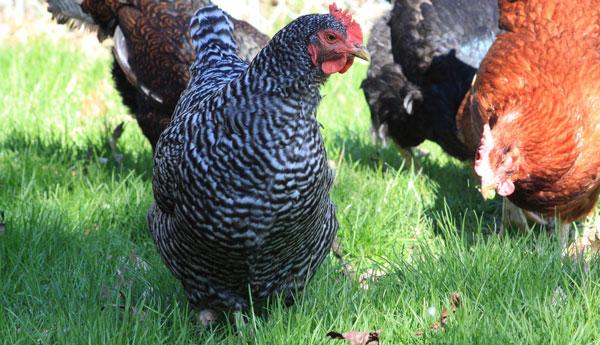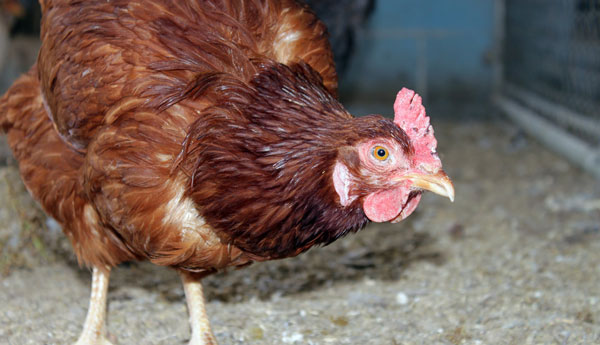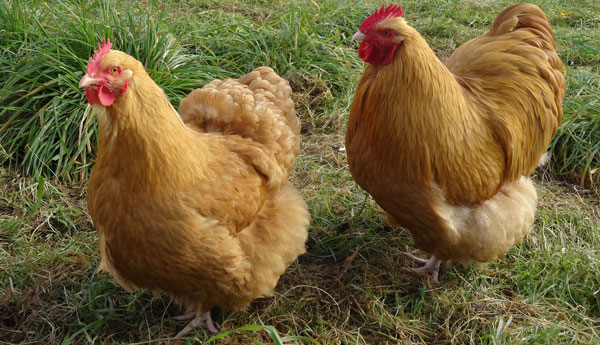
As springtime approaches, that tends to mean one thing around my homestead. The chickens, long self-confined to a smaller grazing ground have begun to range again, scratching their way through underbrush and tree, grass and, yes, even garden. As I’m watching them, I’ve begun to realize it’s been a little while since I last profiled any chicken breeds on here, so without further ado, I give you the second installment of my (hopefully) long running series on chickens.

Barred Rocks
A variant of Plymouth Rock chicken, sharing their name with the landing point of our Pilgrim antecedents, these chickens are a quintessentially American breed created in the early 1800s by crossing Dominiques and Black Javas. A stalwart brown egg layer–producing somewhere around 200 eggs per year–the chickens were originally developed in New England, and are thus incredibly resistant to cold. Should your needs be more meat-centric, the chickens are plump at maturity with yellow skin, making for an excellent roasting bird. Physically, the chickens (hens and roosters) are striped black and white, while the chicks are dark grey with white splotches. Bodies are triangular, with a wide chest and a lengthy back, making for a hen around 7.5 pounds, and roosters around 8. Combs are five pointed. In terms of temperament, the breed is quite docile, though they do start out aloof. After some time however, the breed will warm up to its owner, particularly if you take the time to hand feed them. The hens can also go broody, though it takes a little encouragement (always leaving eggs in the same nest).

Rhode Island Red
Sticking with our New England theme, we come to the Rhode Island Red. Kicked off in 1854 by sea captain William Tripp’s purchase of a Malay rooster, the Rhode Island Red is the product of a fair amount of crossbreeding among Light Brahmas, Plymouth Rocks, Leghorns and more. A utilitarian breed, they are of average size (hens around 6.5 pounds, roosters around 8.5), and though initially bred to be dual-purpose, excel at egg laying–the birds produce somewhere around 250-260 eggs per year. While the hens are said to have broodiness bred out of them, they can occasionally still go broody, though it’s not common. As with Barred Rocks, a little encouragement can go a long way in this department. In temperament, the ginger hens are somewhere near the middle of the pecking order, with a quiet, friendly temperament. Roosters, however, with their shimmering green highlights, are known to be fairly aggressive.

Buff Orpington
The classic English egg layer, the Buff Orpington is likely the first chicken you associated with fresh eggs as a child. Created through the interbreeding efforts of William Cook in, the Buff Orpington was actually his second creation, behind the original Black Orpington (colored as such to hide the soot and dirt prevalent in industrial cities of the time). The birds are large–around 10 pounds for males and 8 for females–with broad, low-centered bodies. Feet, shanks and beak are all pinkish-white, while wattles and comb are red. The combs do come in two varieties–one five pointed, and the other a rose. As far as disposition goes, they are more friendly than other breeds, and will sometimes even seek you out for company. A fluffy coat of feathers keeps them warm in the cold, but make sure you keep them dry–the feathers can become saturated easily, which will freeze the birds to death in poor weather. Buff Orpingtons are also a dual purpose breed, but they are a steady brown egg layer, the task for which I usually use the birds. You can expect somewhere around 250 eggs per year. Buff Orpingtons hens are also very likely to go broody, usually occuring at least once per summer.
I hope you’ve enjoyed these three new breed profiles. Stay tuned for more, as well as potentially a deeper exploration of factors that can cause broodiness, as I’ve seen a fair amount of interest in the topic.
A humble homesteader based in an undisclosed location, Lars Drecker splits his time between tending his little slice of self-sustaining heaven, and bothering his neighbors to do his work for him. This is mainly the fault of a debilitating predilection for fishing, hunting, camping and all other things outdoors. When not engaged in any of the above activities, you can normally find him broken down on the side of the road, in some piece of junk he just “fixed-up.”

Jim says
Great article, look forward to future ones, thanks! What breed you recommend for hot and humid Florida (we have already hit the 90’s here! Thanks again.
Dave says
What hen would you recommend for a hot and dry environment like Texas?
Bud Savoie says
Being New Englanders, my wife and I had a flock of Rhode Island Reds and Barred Rocks. A bit of arcane knowledge: all New England breeds lay brown eggs, which we locals insist taste better than white ones. You are right about the RI Red roosters–we had one called Charlemagne who was as mean as a rooster could be. You had to keep your eye on him every second or he would jump you and flog/bite/spur you, the ingrate. And he bullied the Rock roosters until they wouldn’t crow any more. You didn’t mention that the RI Red was bred by one Isaac Wilber [sic] of the great State of Rhode Island, a family ancestor of my wife’s.
Mark Rackin says
Might be useful to include definitions for some of the jargon; “broody” is the first one!
TJ says
A broody chicken is one that lays on eggs to hatch them.